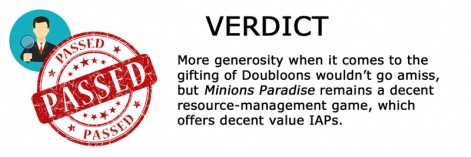Welcome back to the In-App Purchase Inspector - our regular look at free-to-play games from the consumer's perspective.
In each instalment, we consider the incentives or pressure applied to make in-app purchases, their perceived value, the expansion offered by IAPs and the overall value of the experience.
The end goal is to see whether the game makes a good enough case for us to part with our cash, or whether players are content - or engaged enough - to 'freeload'.
This time, we're taking a look at Minions Paradise, Illumination Entertainment and EA's official mobile game based on the inexplicably popular yellow creatures from Despicable Me.
Wrecked
Minions Paradise went down like a lead balloon when it was unveiled on stage at EA's E3 2015 conference.
But then it would, wouldn't it? Because Minions Paradise isn't for the sort of people streaming E3 conferences (although, if they gave it a chance, they might just feel it digging its hooks in).
It's the sort of casual resource-management game that's keen to alienate absolutely nobody, from children who actually like the squeaky, yellow horrors to commuters sick of Candy Crush.
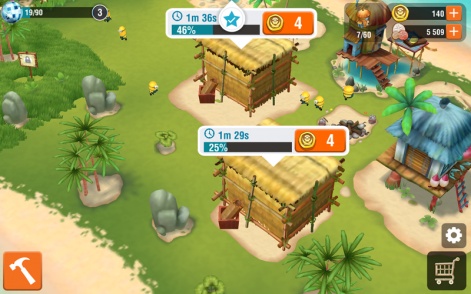
Charged with operating a functioning island society for a minion population that (somewhat understandably) hates you for clumsily sinking their luxury cruise liner, you're responsible for expanding the island and its facilities to the extent that more minions want to move there.
Minions Paradise is a casual resource-management game that's keen to alienate absolutely nobody.
However, much like King's Paradise Bay, it's can feel like a Sisyphean struggle - building new facilities only to unlock the potential for more, growing natural resources only to collect and replant ad infintum, fulfilling one minion's request only for it to be replaced with another.
It taps into the most primitive and exploitable part of the human brain; the bit that's happy to spend hours and hours repeating the same basic actions just for another shot of that inexplicable contentment that comes from watching numbers steadily increase.
Sometimes, that contentment alone is enough reason to spend money on things.
Money doesn't grow on (coconut) trees
Minions Paradise does have a lot in common with Paradise Bay, and it makes for a rather interesting comparison.
Currency-wise, EA's effort is notably tighter. Starting you out with around 20 Doubloons - Minions Paradise's hard currency - this equates to around $0.90 in real money and won't last you long.
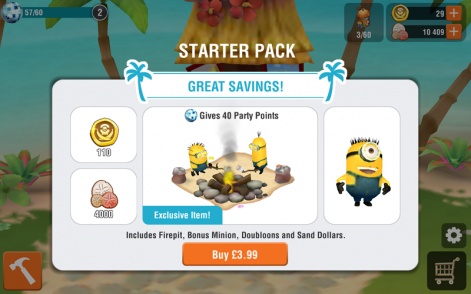
It's also worthy of note that the game eschews the popular mechanic of allowing the player to skip the first couple of wait timers.
Admittedly, the cost of skipping these initial wait timers - a mere 1-2 minutes in duration - is only 2 Doubloons, but it is rare that a F2P game allows the player to spend even a small amount of hard currency while it's still effectively explaining the mechanics.
Furthermore, systems for which I praised Paradise Bay - hard currency appearing in chests, an achievement system that gifted gems - are absent in Minion's Paradise.
This means that you'll largely have to pay for your Doubloons, which come in packs ranging from 110 for $4.99 to 2,800 for $99.99.
For a long time, this isn't too much of a problem. While some games immediately establish a rhythm in which you leave production ticking over and check in only irregularly, Minions Paradise is smart about saving the longer build times for after it's got its hooks in.
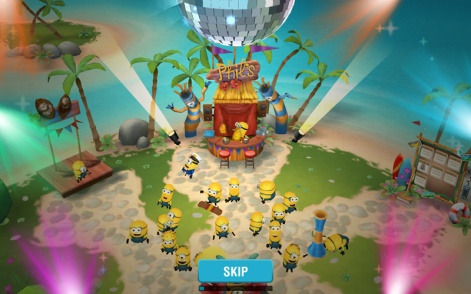
Indeed, as mentioned previously, the first phase of the game involves simple tasks and wait timers that rarely exceed 5 minutes, ensuring that the player always has something to watch over and - crucially - isn't pressured heavily to spend.
The ability to build multiple structures at once is also a nice touch.
The ability to build multiple structures at once is also a nice touch, unlike the many games in which you're prompted to pay in order to complete one before work can begin on the next.
Desert island? Party island
However, despite these differences, the bread and butter of both Minions Paradise and Paradise Bay remains very similar.
Hard currency skips timers and buys missing resources, soft currency is used to build stuff, and progress means unlocking more and more facilities for growing or manufacturing resources.
You can buy soft currency (Sand Dollars), too, in packs ranging from $2.99 for 2,000 to $79.99 for 62,000 - although why you'd want to beats me, as it's in pretty plentiful supply.
But otherwise, like Paradise Bay, it's pretty straight down the line with its monetisation - nothing really experimental, no advertising, just your basic dual-currency approach.
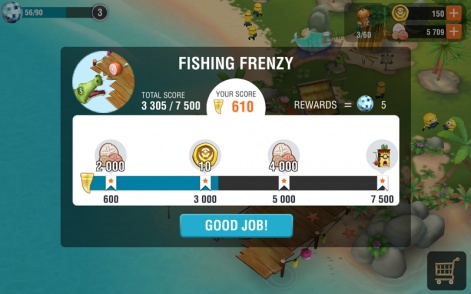
One area in which it does differ, however, is in minigames - again, another example of EA trying to keep its players in-game for as long as possible. The first of these, Fishing Frenzy, is a simple one-tap runner style game that's available from the start.
For each play you earn 5 Party Points - enough of which will see your island level up and welcome more minion residents - and at certain point milestones you can earn Sand Dollars.
Mostly, it's a distraction while you're waiting for something else to complete. However, after a few tries - it's a very simple affair, lasting no longer than 30 seconds - it starts to lose its appeal.
As such, for $6.99, you can immediately unlock four additional minigames. While these can be unlocked through normal play, each is surrounded by heavily overgrown land, requiring you to repair bridges and clear the surrounding area with Sand Dollars to reach them - a lengthy process.
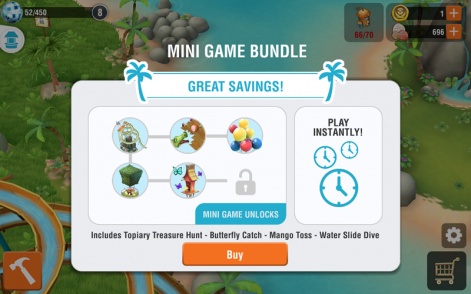
This seems like an IAP that's aimed primarily at the younger audience and their parents, and is probably a shrewd business decision. However, as someone not particularly enthused by the idea of paying for what are - judging by Fishing Frenzy - incredibly basic games, it wasn't for me.
Shelling out
Instead, it was once again a starter pack that seemed best-suited to my needs. This time, $4.99 got me 110 Doubloons - the same value as the lowest tier - along with 4,000 Sand Dollars and an exclusive Firepit item, along with an extra minion.
Minions Paradise is a little less generous than competitors.
That turned out to be a great purchase to get through the first stages, although the game's aforementioned tight-fistedness with Doubloons quickly rebuilds the pressure.
Now fresh out of Doubloons, and with progress not quite halted but noticeably slowed, I find myself at a crossroads: do I slog it out, pay again, or simply stop playing?
Well, where Minions Paradise excels is in getting its hooks in - and I fear they're already too deep to pursue the latter path. However, it does feel a little early to be paying again.
So it seems I'll be plodding on with Minions Paradise, and at this stage I can't rule out spending again in future. But for now, I've had my taste of what Doubloons can do, and am willing to earn my keep for a while.
In summary, then, Minions Paradise is a little less generous than competitors, but somehow it's no less compelling. Things certainly tighten up as you progress, though.
